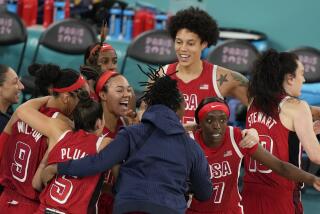THE GOODWILL GAMES : U.S. Women Win Final in Sort of Miracle on Wood
- Share via
MOSCOW — When the U.S. women’s basketball team arrived at the Druzhba Gym Thursday for a 1 p.m. workout, seven hours before it was to play the Soviet Union for the Goodwill Games championship, Coach Kay Yow informed the players that she was changing the offense.
After the players learned one offense during the three-week training camp in Hilton Head, S.C., and used it effectively in winning all four games they had played in Moscow, Yow gave them another offense, one she said would enable them to use their speed and quickness to greater advantage.
She also told them that the new offense would create confusion. For which team, they wondered.
Cheryl Miller said she was not optimistic when the workout ended an hour later. “I didn’t know if this was going to work,” she said.
About 10 minutes into the first half, she found out. The United States took the lead midway through the first half and never looked back, winning, 83-60.
It was a victory for the ages--one perhaps remindful of the U.S. ice hockey win over the Soviets at the 1980 Lake Placid Winter Olympics--since the Soviets had dominated international women’s basketball for the last three decades.
The Soviets are touchy about the subject. According to a pamphlet prepared for the Goodwill Games by the Soviet Sports Committee: “The claims that the Americans have always dominated world basketball require but one substantial reservation.
“The point is that it is the Soviet sportswomen that have always set the tone in women’s basketball. No team in any other sport or in any other country boasts a service record that could match that of the USSR women’s basketball selects.”
Indeed, since women began playing internationally in 1953, the Soviets have a record of 148-2 in major competitions--the Olympics, world championships and European championships. Their only losses have been to the United States in the 1957 world championships and to Bulgaria in the 1958 European championships.
Before Thursday night, they had never lost a game in the Soviet Union. But it was apparent even before then that the United States was closing the gap. In a 1982 tournament at Budapest, Hungary, the Americans beat the Soviets for the first time in 25 years. A year later, the Americans won again in an exhibition at Kansas City.
When it counted, however, the Soviets still were the best, although not by much. “A hair’s breadth,” the Soviet pamphlet called it. In the 1983 world championships at Sao Paolo, Brazil, the Soviet Union beat the United States in a preliminary game, 85-84, then again in the final, 84-82.
That was the end of an era. After the announcement of the 1984 Olympic boycott, the veteran Soviet coach retired and was replaced by Vadim Kapranov, who brought a Western, run-and-gun style to the Soviet women’s team. But even though he had success in last year’s European championships, Kapranov has discovered that his runners and gunners sometimes turn into a gang that can’t shoot straight against faster teams.
Such was the case Wednesday night, when the Soviet Union met Brazil. After winning their first three games against plodding Eastern Bloc teams, the Soviets found themselves 20 points behind against the slick Brazilians.
Kapranov’s solution was to resort to the Soviets’ old game, which consists primarily of passing the ball inside to the veteran 6-foot 11 1/2-inch Iulijana Semenova.
Even though Semenova, 34, had been the dominant player in the game for more than a decade, she averaged only nine points in the first four games of this tournament in a reserve role. But in the final half against Brazil, she scored 20 points as the Soviets rallied to win, 78-73.
Kapranov was expecting a similar lift from Semenova against the United States. But instead, her appearance had the effect of inspiring the Americans, center Anne Donovan in particular.
One of three U.S. players who also participated in the gold-medal winning effort at the 1984 Olympics, the 6-8 Donovan is well-coordinated and intelligent but has a reputation for excessive timidity. That was not the case in this tournament, especially not against Semenova, who had one shot slapped back into her face by Donovan. Donovan paid for it with an elbow to the mouth, but, as far as she was concerned, it was all in good fun.
Yow’s new offense also enabled the Americans to exploit Semenova’s lack of quickness on defense. The Pushkin statue moves better than Semenova does, and also jumps better. Semenova lost a tip in the second half to 6-0 Fran Harris.
Instead of settling near the basket and waiting for the offense to come to them, as they did in the previous system, the U.S. centers were instructed to start in the high post, near the free-throw line, and to move around, taking Semenova with them. That left the lane open for the quick guards and forwards, who drove around their defenders time after time for easy baskets.
The Soviets never adjusted to Yow’s new offense.
“We caught them with their shorts down,” said Miller, who, given freedom to create her own offense, had 18 points and 10 rebounds. She finished the tournament as the United States’ leading scorer, averaging 24 points a game. She also averaged 12 rebounds.
Kapranov said later he made a mistake by using Semenova, who had 0 rebounds and 4 points in 17 minutes. The U.S. centers, Donovan and Katrina McClain, combined for 25 points and 18 rebounds. The Americans outrebounded the Soviets, 44-20.
“It was a psychological break for them,” Kapranov said of his decision to play Semenova. “After that, everything was unlucky.”
When Semenova entered the game with 11:39 remaining in the first half, the Soviets trailed, 13-12. A little more than two minutes later, they had a 21-19 lead. But they didn’t score another point for five minutes and had only one more field goal in the first half. When Semenova went to the bench with 4:25 remaining, the United States led, 30-22. By the half, the U.S. team had extended its lead to 39-25.
A capacity crowd of 7,000 at Druzhba Gym included about 1,000 Americans, who were whistled down at the start of the game after chanting, “USA, USA.”
But by the start of the second half, the Soviet fans, obviously disgusted with the play of their team, let the American supporters have their fun. The result was the first recorded wave in the Soviet Union.
The Soviet players may have given up before their fans.
“They play like robots,” Donovan said. “You don’t see any emotion at all. What you don’t see is heart.”
In contrast, the U.S. players were high-fiving as soon as they come on the court for the pre-game workouts.
“In seven years with the program, I’ve never seen a more unified team,” said Barbara Gill, chairman of the U.S. basketball federation’s women’s committee. “To think that they’ve been together for three weeks and beat a Soviet team that’s been together for over a year, and by 23 points, it’s amazing.”
Miller said she enjoyed playing with the U.S. team so much that she’s coming back for more.
The players on this team also have been selected to play in the Soviet Union at the world championships next month, but Miller said earlier that she might not return. She since has decided to play.
“I can’t quit now,” she said. “I’m having too much fun.”
While on the subject of fun, one of the questions asked of Yow at the post-game press conference came from a representative of Crocodile, a Soviet humor magazine. He asked if the Soviets could ever again expect to beat the Americans.
“It’s too soon to make a sweeping statement,” said Yow, who coaches at North Carolina State. “In this case, quickness and technique won out over height and experience. But the next time, who knows?”
Another Soviet reporter was critical of Kapranov for not having any players on his team from Novosobirsk, a Siberian city about seven hours by air from Moscow. Novosobirsk, apparently, has a hot club team. If the Soviets don’t improve in the world championships, Kapranov might be spending a lot of time there.
More to Read
Go beyond the scoreboard
Get the latest on L.A.'s teams in the daily Sports Report newsletter.
You may occasionally receive promotional content from the Los Angeles Times.






